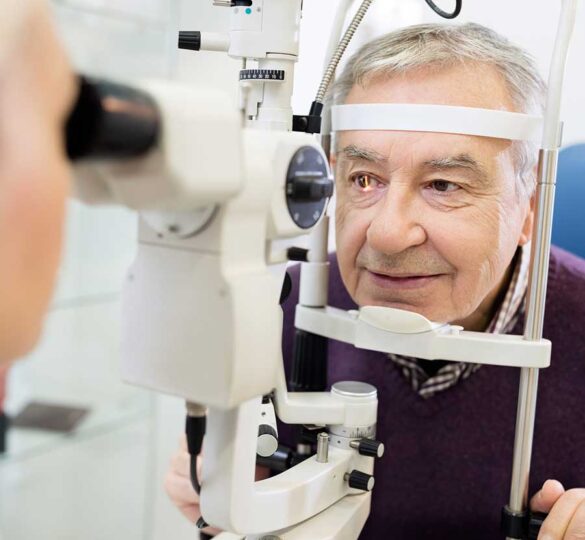Study Proves Lowering IOP Preserves Vision
Prior to 1998, doctors could not agree on whether intraocular pressure (IOP) was involved in optic nerve damage, even when IOP was in the normal range. But a study sponsored by Glaucoma Research Foundation changed all that!

The Collaborative Normal Tension Glaucoma (NTG) study (CNTGS) was the first of its kind to compare patients with any kind of glaucoma who received IOP-lowering treatment versus those who received no treatment.
Involving hundreds of volunteer subjects for over a decade, this international collaborative effort addressed three critical questions:
- Does IOP play a role in glaucoma, even at normal levels?
- Is it clinically feasible and worthwhile to lower eye pressure in patients with NTG?
- Do the benefits of lowering eye pressure outweigh any risks and side effects?
Some of these major study findings were published in the October 1998 issue of the American Journal of Ophthalmology.
Study Background
Normal-tension glaucoma (NTG), also known as normal or low-tension glaucoma, is unique because damage to the optic nerve and resulting visual field loss occur even when the IOP is consistently below 21 mmHg (which is considered upper limit of normal). For many years, the primary cause of NTG was uncertain, and so there was no solid evidence that reducing eye pressure was the correct treatment.
To begin addressing this, Glaucoma Research Foundation sponsored an interdisciplinary seminar that led to the CNTGS study in 1984. The multi-center collaborative trial began in 1986 and involved 24 study centers worldwide. To this day, it is considered one of the most pivotal glaucoma studies ever conducted!
The study randomly assigned volunteer subjects with confirmed NTG into two arms:
- Observation Group: Carefully monitored for NTG progression (change in visual field or optic nerve appearance) but received no IOP-lowering treatment.
- Treatment Group: Aimed to achieve a 30% reduction in baseline IOP using available treatments, including eye drops, laser, and/or filtering surgery.
Results: Lowering Eye Pressure Makes a Difference
The scientific findings clearly showed that lowering eye pressure significantly slows progression of NTG. These results proved that IOP, even in the normal range, plays an active role in the disease process.
However, the study also provided crucial insights into the variability of NTG:
- Treatment worked, but not for everyone: While the treated group had a much lower rate of progression overall, approximately 16% of treated subjects (approx.1 of every 6) still experienced disease progression despite achieving the goal of 30% IOP reduction.
- Many untreated eyes exhibited slow progression: About two-thirds (2/3) of the untreated/observation group showed little or no progression in the first three years, though the majority eventually showed some progression over the long term. This confirmed that NTG can progress very slowly.
The study concluded that there was still a lot to learn about the causes and progression of normal tension glaucoma other than eye pressure.
Follow-up studies focused on improving patient outcomes
CNTGS data has been crucial for helping eye care professionals individualize treatment. Follow-up studies have identified specific risk factors that make a patient much more likely to progress, providing much-needed guidance to their doctors on which patients need immediate, aggressive treatment and which might be initially monitored safely.
Key Risk Factors for NTG Progression Identified in Follow-up Studies:
- Disc Hemorrhage: The presence of small bleeding spots on the optic nerve head is considered one of the strongest predictors of progression.
- Female Sex and History of Migraine: Both were found to be associated with a faster rate of visual field deterioration.
- Early Visual Field Defect: Having a localized defect close to the central vision (fixation) at the start of the study.
The study also highlighted the need to weigh treatment benefits against risks, particularly regarding surgically lowering pressure. Specifically, patients in the treatment arm who underwent glaucoma filtering surgery (trabeculectomy) had a significantly increased chance of developing cataracts—a known complication of this procedure. Therefore, a clinician must carefully balance the risk of cataract development (which is typically treatable with modern cataract surgery) against the risk of irreversible vision loss from NTG progression.
Today, the clinical consensus based on the CNTGS data is to target a 30% or greater reduction in IOP for all NTG patients identified as being at high risk of progression (e.g., those with disc hemorrhages or rapid visual field loss). For low-risk patients with very slow or non-existent progression, a more cautious approach and close observation may still be appropriate.
With any form of glaucoma, it is important to consult your eye doctor with your questions and concerns. If you have normal-tension glaucoma and any of the additional risk factors mentioned above, ask your doctor about your eye pressure and what other treatment options may be available to you to keep your pressures low to decrease risk of vision loss.
Reviewed, revised, and updated November 25, 2025, by Cynthia Steel, PhD, MBA.

Cynthia Steel, PhD
Cynthia Steel, PhD is the Chief Scientific Officer for Glaucoma Research Foundation. With more than a decade of experience dedicated to the science and strategy behind ophthalmic therapies, her work is grounded in a commitment to improving patient outcomes and translating cutting-edge science into meaningful clinical applications.